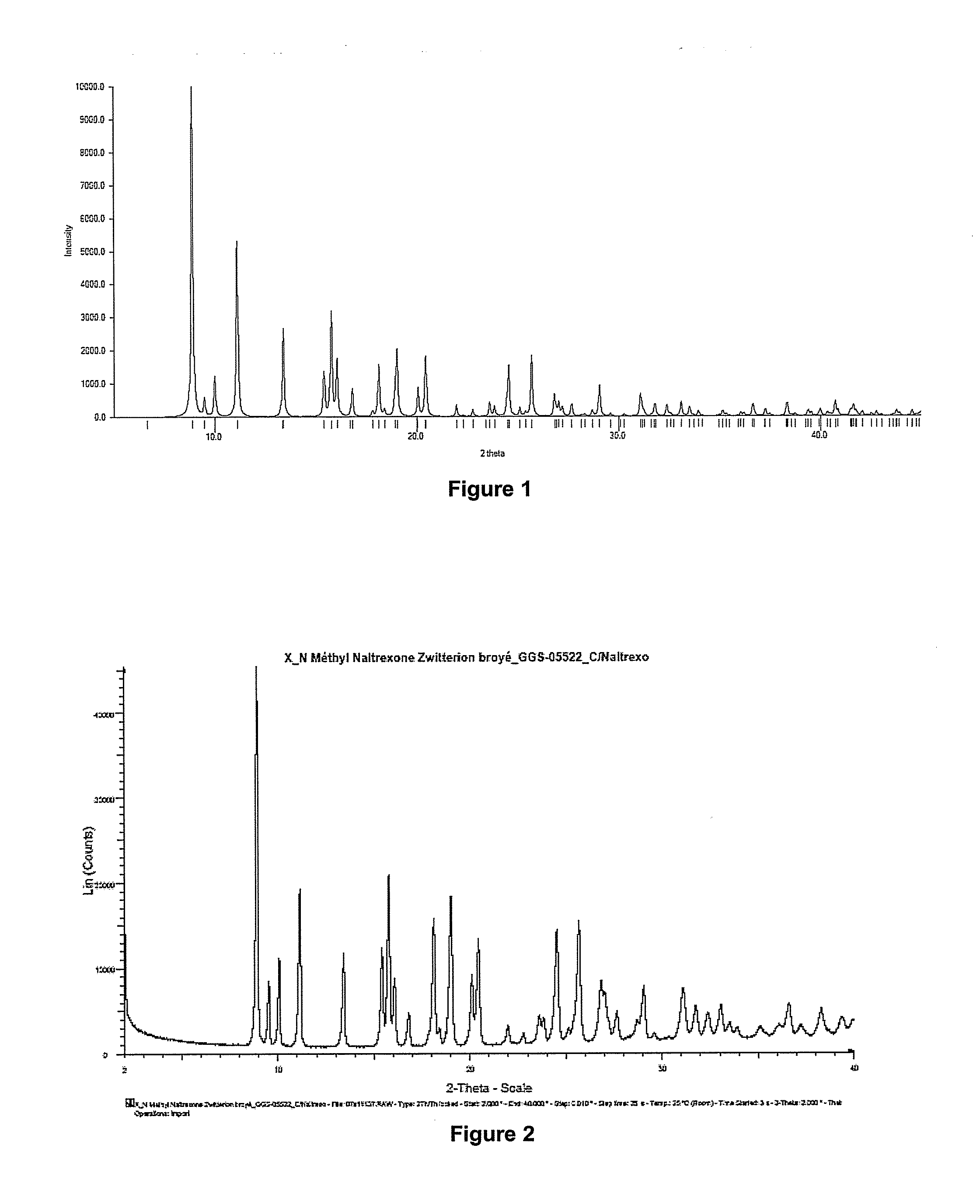Process for preparing n-alkylnaltrexone halides
a technology of n-alkylnaltrexone and halide, which is applied in the field of process for preparing n-alkylnaltrexone halide, can solve the problems of unsatisfactory yield and incompatible with the desired industrial application
- Summary
- Abstract
- Description
- Claims
- Application Information
AI Technical Summary
Benefits of technology
Problems solved by technology
Method used
Image
Examples
example 1
Preparation of N-Methylnaltrexone Bromide
1.1 Preparation of Crude Base Naltrexone (Step 1; N-alkylation)
[0053]100 g (0.27 mol) of noroxymorphone hydrochloride, 80.8 g (0.96 mol; 3.55 eq.) of sodium hydrogen carbonate and 300 ml of dimethylacetamide are successively introduced into a 500 ml reactor equipped with a condenser and a mechanical stirrer. The reaction medium is heated to between 65° C. and 69° C.
[0054]At the end of the observed evolution of gas (about 10 minutes), 35 ml of bromomethylcyclopropane (0.44 mol; 1.6 eq.) are introduced over 30 minutes while keeping the temperature at 69° C.
[0055]The N-alkylation is complete in about 6 hours, and the reaction progress is monitored by HPLC analysis (residual content of noroxymorphone less than or equal to 0.5%). The reaction medium is cooled to 50° C. and then poured with stirring over 1 hour into a mixture of 1000 ml of water and 100 g of sodium chloride preheated to 50° C.
[0056]The pH is adjusted to 8.6-9 by addition of 8 ml of...
example 2
Preparation of N-Methylnaltrexone Bromide (Step 5: Methyl Sulfate / Bromide Exchange, Variant without Isolation of the Intermediate
[0120]The aqueous solution from step 4 of Example 1 is concentrated under vacuum until a residual volume of 30 ml is obtained, and 1 g of Na2CO3 is then introduced until a pH of about 9.5 to 9.8 is obtained (natural pH of sodium carbonate in water).
[0121]The reaction medium is maintained at 20° C. with stirring for 1 hour, 2.1 ml of 48% hydrobromic acid are then added over 1 hour, i.e. down to a pH of about 1, and the reagents are left in contact with stirring for a further 1 hour.
[0122]The insoluble matter of the reaction medium is filtered off by suction and this filter cake is washed with 10 ml of acetone and then dried in an oven under vacuum (10 mmHg) at 40° C. for 12 hours.
[0123]9.35 g of a mixture of crude N-methylnaltrexone bromide and of mineral salts (NaBr and NaMeSO4; titer of crude N-methylnaltrexone bromide: 50%) are obtained.
example 3
Preparation of N-Methynaltrexone Bromide (Step 5: Methyl Sulfate / Bromide Exchange, Variant without Isolation of the Intermediate, with MeOH)
[0124]In step 5 of the process of Example 1, after treatment with HBr, 40 ml of methanol are added and the mixture is then maintained at 60° C. until the dissolution is virtually complete. The light insoluble matter (undissolved N-methylnaltrexone bromide) is filtered off.
[0125]The filtrate (MeOH / H2O mixture) is cooled to 0° C. The crude MNTX bromide crystallizes on cooling, and is then filtered off by suction.
[0126]The major advantage of this variant is the solubilization of mineral salts (NaBr, NaCH3SO4) in the methanol / water mixture, whereas NaBr is slightly soluble in the ethanol / water mixture.
PUM
| Property | Measurement | Unit |
|---|---|---|
| temperature | aaaaa | aaaaa |
| temperature | aaaaa | aaaaa |
| temperature | aaaaa | aaaaa |
Abstract
Description
Claims
Application Information
 Login to View More
Login to View More - R&D
- Intellectual Property
- Life Sciences
- Materials
- Tech Scout
- Unparalleled Data Quality
- Higher Quality Content
- 60% Fewer Hallucinations
Browse by: Latest US Patents, China's latest patents, Technical Efficacy Thesaurus, Application Domain, Technology Topic, Popular Technical Reports.
© 2025 PatSnap. All rights reserved.Legal|Privacy policy|Modern Slavery Act Transparency Statement|Sitemap|About US| Contact US: help@patsnap.com



